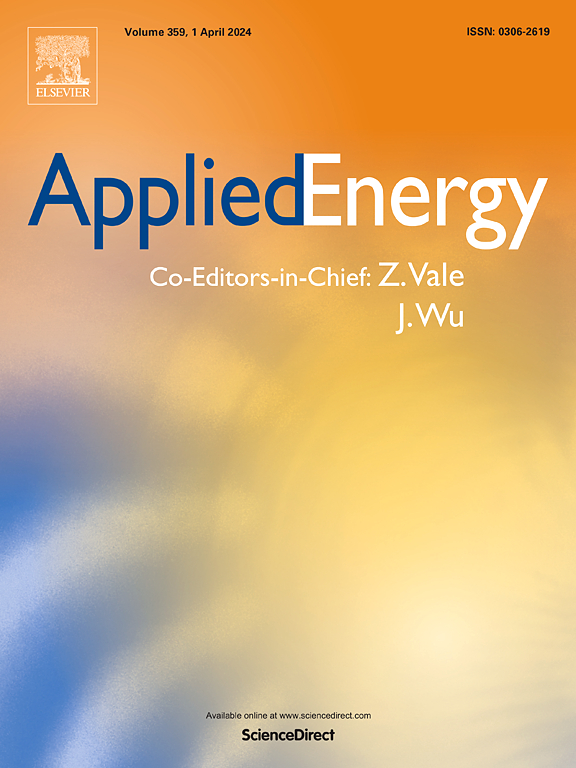Spatial planning for China’s renewable energy expansion toward 2030
IF 11
1区 工程技术
Q1 ENERGY & FUELS
引用次数: 0
Abstract
China is rapidly advancing renewable energy deployment to decarbonize the power system and meet its ambitious climate targets. However, existing energy models have limitations in simulating resource availability, generation variability, and grid integration in a consistent framework with high temporal and spatial resolution, making it difficult for them to effectively guide policy formulation. In this paper, we develop a model that can co-optimize capacity expansion and operation for China’s power system at the hourly level in a full year and a grid cell level of for wind and solar power deployment, which is unprecedented in terms of temporal and spatial resolution. Applying this modeling tool to inform renewable deployment during the 15th Five-Year Plan (2026-2030), we find that China will have cumulatively 766 GW of wind power and 1880 GW of solar power installations to generate 4.9 PWh/yr by 2030 in the base case, close to the coal power output (5.3 PWh/yr). We further find that onshore wind installations are concentrated in the “Three North” regions, offshore wind installations are concentrated along the coasts of Fujian, Zhejiang, and Guangdong, and large-scale solar installations are scattered in northern, eastern, and southern China. An additional 350 GW of inter-provincial ultra-high voltage transmission and 1200 GWh of energy storage will be installed during the 15th Five-Year Plan to balance the increased renewable installations. The simulated marginal cost of electricity production reveals an increased variability, presenting challenges for power market regulations. It is recommended to prioritize spatial planning for renewable energy installations and related industries, and emphasize the critical role of cost-effective storage technologies and ultra-high voltage inter-provincial transmissions.
2030年中国可再生能源发展空间规划
中国正在迅速推进可再生能源的部署,以使电力系统脱碳,实现其雄心勃勃的气候目标。然而,现有的能源模型在高时空分辨率的一致框架下模拟资源可用性、发电变异性和电网整合方面存在局限性,难以有效指导政策制定。在本文中,我们开发了一个模型,该模型可以在全年小时水平和0.1°×0.1°的电网单元水平上共同优化中国电力系统的容量扩展和运行,用于风能和太阳能的部署,这在时空分辨率上是前所未有的。应用该建模工具为“十五”规划(2026-2030年)期间的可再生能源部署提供信息,我们发现,到2030年,中国将累计拥有766吉瓦的风力发电和1880吉瓦的太阳能发电装置,在基本情况下,发电量将达到4.9 PWh/年 ,接近煤炭发电量(5.3 PWh/年)。我们进一步发现,陆上风电装置集中在“三北”地区,海上风电装置集中在福建、浙江和广东沿海,大型太阳能装置分散在中国北部、东部和南部。在“十五”期间,将新增350吉瓦的跨省超高压输电和1200吉瓦时的储能,以平衡可再生能源装机容量的增加。模拟的电力生产边际成本揭示了变异性的增加,对电力市场监管提出了挑战。建议优先规划可再生能源设施和相关产业,强调高性价比储能技术和超高压跨省输电的关键作用。
本文章由计算机程序翻译,如有差异,请以英文原文为准。
求助全文
约1分钟内获得全文
求助全文
来源期刊

Applied Energy
工程技术-工程:化工
CiteScore
21.20
自引率
10.70%
发文量
1830
审稿时长
41 days
期刊介绍:
Applied Energy serves as a platform for sharing innovations, research, development, and demonstrations in energy conversion, conservation, and sustainable energy systems. The journal covers topics such as optimal energy resource use, environmental pollutant mitigation, and energy process analysis. It welcomes original papers, review articles, technical notes, and letters to the editor. Authors are encouraged to submit manuscripts that bridge the gap between research, development, and implementation. The journal addresses a wide spectrum of topics, including fossil and renewable energy technologies, energy economics, and environmental impacts. Applied Energy also explores modeling and forecasting, conservation strategies, and the social and economic implications of energy policies, including climate change mitigation. It is complemented by the open-access journal Advances in Applied Energy.
 求助内容:
求助内容: 应助结果提醒方式:
应助结果提醒方式:


